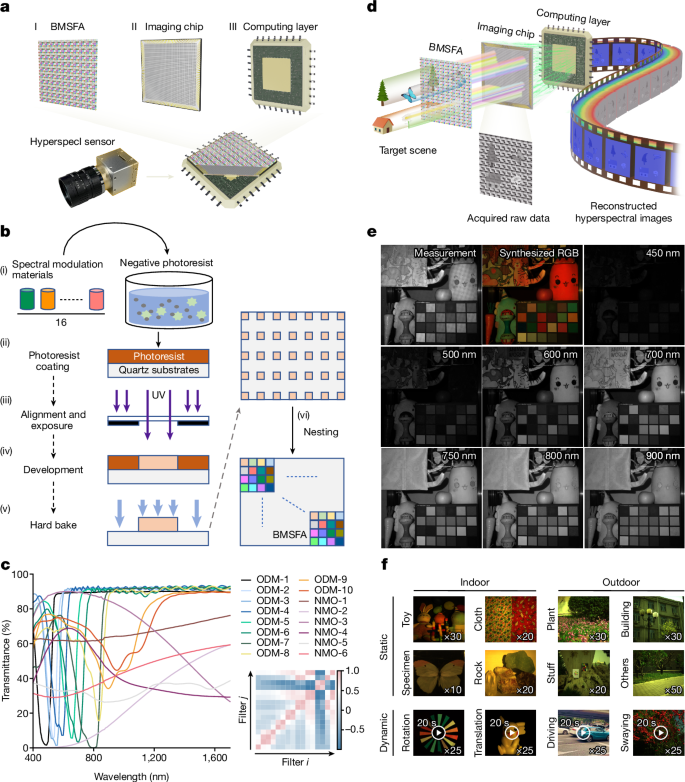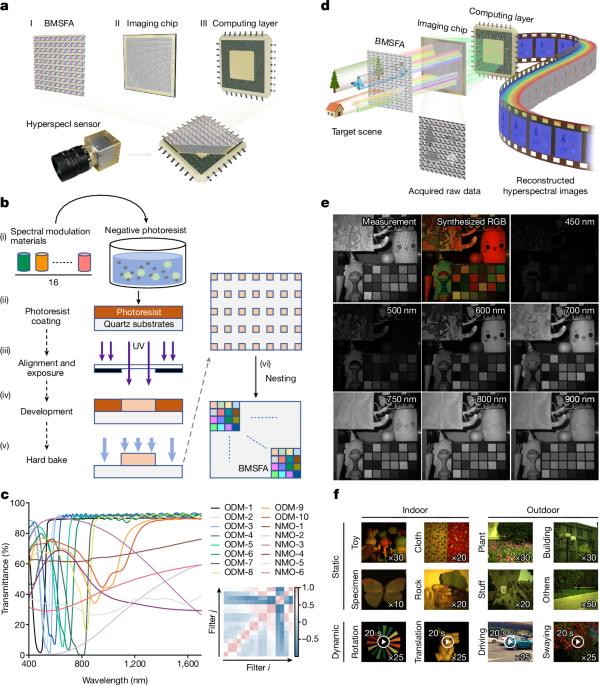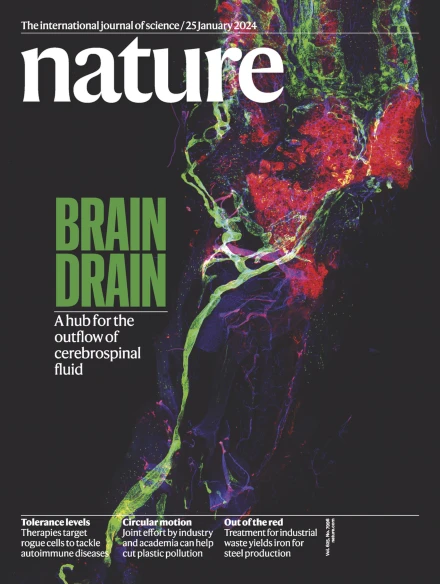A broadband hyperspectral image sensor with high spatio-temporal resolution
IF 50.5
1区 综合性期刊
Q1 MULTIDISCIPLINARY SCIENCES
引用次数: 0
Abstract
Hyperspectral imaging provides high-dimensional spatial–temporal–spectral information showing intrinsic matter characteristics1–5. Here we report an on-chip computational hyperspectral imaging framework with high spatial and temporal resolution. By integrating different broadband modulation materials on the image sensor chip, the target spectral information is non-uniformly and intrinsically coupled to each pixel with high light throughput. Using intelligent reconstruction algorithms, multi-channel images can be recovered from each frame, realizing real-time hyperspectral imaging. Following this framework, we fabricated a broadband visible–near-infrared (400–1,700 nm) hyperspectral image sensor using photolithography, with an average light throughput of 74.8% and 96 wavelength channels. The demonstrated resolution is 1,024 × 1,024 pixels at 124 fps. We demonstrated its wide applications, including chlorophyll and sugar quantification for intelligent agriculture, blood oxygen and water quality monitoring for human health, textile classification and apple bruise detection for industrial automation, and remote lunar detection for astronomy. The integrated hyperspectral image sensor weighs only tens of grams and can be assembled on various resource-limited platforms or equipped with off-the-shelf optical systems. The technique transforms the challenge of high-dimensional imaging from a high-cost manufacturing and cumbersome system to one that is solvable through on-chip compression and agile computation. A broadband hyperspectral image sensor fabricated using photolithography maintains high throughput with high spatial–temporal–spectral resolution, and has demonstrated wide applications including chlorophyll and sugar quantification, blood oxygen and water quality monitoring, textile classification, apple bruise detection, and remote lunar detection.


具有高时空分辨率的宽带高光谱图像传感器
高光谱成像提供高维时空光谱信息,显示物质的内在特征1,2,3,4,5。在此,我们报告了一种具有高空间和时间分辨率的片上计算高光谱成像框架。通过在图像传感器芯片上集成不同的宽带调制材料,目标光谱信息以高光吞吐量非均匀和内在地耦合到每个像素上。利用智能重构算法,可以从每一帧图像中恢复多通道图像,实现实时高光谱成像。根据这一框架,我们利用光刻技术制造了宽带可见光-近红外(400-1700 nm)高光谱图像传感器,其平均光吞吐量为 74.8%,有 96 个波长通道。演示的分辨率为 1,024 × 1,024 像素,速度为 124 fps。我们展示了它的广泛应用,包括用于智能农业的叶绿素和糖量化、用于人类健康的血氧和水质监测、用于工业自动化的纺织品分类和苹果伤痕检测,以及用于天文学的远程月球探测。集成式高光谱图像传感器仅重几十克,可组装在各种资源有限的平台上,或配备现成的光学系统。该技术将高维成像的挑战从高成本制造和繁琐系统转变为可通过片上压缩和敏捷计算解决的问题。
本文章由计算机程序翻译,如有差异,请以英文原文为准。
求助全文
约1分钟内获得全文
求助全文
来源期刊

Nature
综合性期刊-综合性期刊
CiteScore
90.00
自引率
1.20%
发文量
3652
审稿时长
3 months
期刊介绍:
Nature is a prestigious international journal that publishes peer-reviewed research in various scientific and technological fields. The selection of articles is based on criteria such as originality, importance, interdisciplinary relevance, timeliness, accessibility, elegance, and surprising conclusions. In addition to showcasing significant scientific advances, Nature delivers rapid, authoritative, insightful news, and interpretation of current and upcoming trends impacting science, scientists, and the broader public. The journal serves a dual purpose: firstly, to promptly share noteworthy scientific advances and foster discussions among scientists, and secondly, to ensure the swift dissemination of scientific results globally, emphasizing their significance for knowledge, culture, and daily life.
 求助内容:
求助内容: 应助结果提醒方式:
应助结果提醒方式:


